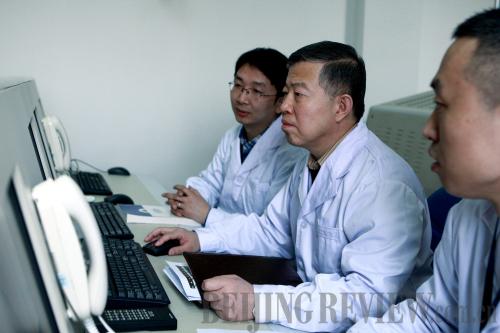|
 |
|
TEAM WORK: Jiang Xingwei (front) analyzes oceanic data transmitted by satellite with his colleague in Beijing (JIANG XIAOYING) |
It is often said mankind knows more about the moon than it does about the depths of the ocean.
Jiang Xingwei, a Chinese satellite scientist, changed the situation with his 30 years of hard work. Thanks to his efforts, observing the ocean with satellites has become a possibility. Jiang is one of the pioneers who developed China's own ocean survey satellite.
"Doing the research and application work of the sea satellite was not my specialty at the very beginning," Jiang said to Beijing Review.
Jiang has devoted himself to ocean science study whole-heartedly since 1982.Just four years earlier, in 1978, the United States launched the world's first sea satellite, Seasat-A. The scientists of other countries, including China, also started to develop their own sea satellites.
In the 1980s, Jiang worked at the State Oceanic Information Center of China. He and his colleagues were doing research work to establish an information system integrating the resources and environment data of islands and coasts. It was a combination of cutting-edge systems at that time in the world, including remote sensing, geographic information systems, and global positioning systems.
In May 1996, Jiang joined the National Satellite Ocean Application Service under the State Oceanic Administration of China, taking on the task of developing China's first sea satellite and ground application system. At that moment, he became a young leader of a research team with an average age of 31.
"Along with the growth of national strength and economy, China is bound to develop its own ocean satellite," Jiang said.
In May of 1999, the Central Government officially approved the project of developing a sea satellite application system. According to the plan, China's sea satellite would be put into operation in 2001, which meant that Jiang, as the chief designer of the project, had to complete the design and construction of the whole system in two years.
"There was no ready model or experience for us to learn from. The stake was high," Jiang said.
Eventually, with efforts of all parties concerned, China's first sea satellite ground application system was successfully completed on schedule under Jiang's leadership. China had established an integrated satellite system for observing the environment including land, atmosphere and ocean.
On May 15, 2002, HY-1A, China's first oceanic satellite, was launched successfully from Taiyuan Satellite Launch Center in Shanxi Province.
But at this joyful moment, an accident happened. HY-1A flew to the wrong position before it entered into pre-selected orbit. Its observing camera did not point to the Earth but to the sun.
Jiang immediately discussed this problem with other experts. They sent command signals through a remote control system to adjust the satellite to the right position. The water color observer on the satellite also stopped working. But scientists were able to resolve the problem in time.
"The success of trouble-shooting inspection reflected our abilities to remote control the satellite," Jiang commented. Some problems did occur. But as China's first sea satellite, it worked well on the whole. "Our experts also gained a lot of experience of the development and operation of sea satellites."
Nevertheless, launching HY-1A was just the first step. Jiang had much more work to do. For example, collecting and analyzing data and offering useful information for the public and society.
Jiang said with the help of the sea satellite, China was able to predict many oceanic disasters over the years, avoiding the loss of people and property.
Today, HY-1A has already retired. Its brother HY-1B, launched in 2007, is also approaching the end of its service life. Jiang and his team are working on new satellite—HY-2.
According to Jiang, China is cooperating with France on sea satellites. The United States and some European countries also proposed to buy the oceanic data generated by HY-2. There is a bright future of international cooperation in this front between China and the other countries.
"China has an objective to build up an integrated sea satellite system consisting of three satellites, HY-1A/B, HY-2 and HY-3," Jiang said. HY-1B uses visible light and infrared spectrum to monitor the changes of the sea. HY-2 uses micro-waves. HY-3 will be equipped with integrated observing devices.
"We will timely renew the remote sensing product information on our official website and contribute to the observation of global climate change," Jiang said.
A Brief Profile of Jiang Xingwei
- 1982, graduated from the Ocean University of China (OUC)
- In the 1980s, worked at the State Oceanic Information Center of China
- 1996, appointed director of National Satellite Ocean Application Service
- 2008, received Ph.D in physical oceanography from the OUC
Email us at: tangyuankai@bjreview.com | 